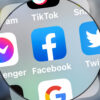The mystery of fast radio bursts (FRBs) continues to fascinate astronomers. No one is quite sure what’s behind these super-short, super-intense radio wave pulses from deep space, but now astronomers have tracked down five FRBs to their home galaxies.
It’s the Hubble Space Telescope that has come up with the goods again. The ultraviolet and infrared cameras on the telescope were used to see where on a star map these five bursts emerged from, which gives us a better understanding of how they might have come into being in the first place.
Before now, only around 15 of the thousand or so FRBs detected to date have been traced back to particular galaxies, so the tracking done on this cluster of bursts is an important indicator of how the phenomenon works.
“Our results are new and exciting,” says astronomer Alexandra Mannings, from the University of California, Santa Cruz. “This is the first high-resolution view of a population of FRBs, and Hubble reveals that five of them are localized near or on a galaxy’s spiral arms. Most of the galaxies are massive, relatively young, and still forming stars.”
“The imaging allows us to get a better idea of the overall host-galaxy properties, such as its mass and star-formation rate, as well as probe what’s happening right at the FRB position because Hubble has such great resolution.”
FRBs generate as much energy in a thousandth of a second as the Sun does in a year, and the more we discover about them, the more intriguing they get. They couldn’t possibly be communications from alien lifeforms… could they? (Probably not, sorry.)
Part of the difficulty in studying these bursts is that they last mere milliseconds and very rarely repeat themselves. Scientists also don’t really know where to look for the next one, which makes tracking down their origins and causes very hard indeed.
That these five were shown to have come from the dimmer parts of spiral arms around galaxies tells experts a lot. Spiral arms are where the hottest, youngest stars in a galaxy hang out, but these FRBs aren’t coming from the brightest parts of the arms.
Four of the FRB locations. (NASA, ESA, Alexandra Mannings, Wen-fai Fong; Image processing: Alyssa Pagan)
As we know which types of stars are and aren’t in spiral arm regions, the findings back up a hypothesis that FRBs probably originate from magnetar stars – dense stars with incredibly powerful magnetic fields, which tend to be found in the FRB sites spotted by Hubble.
“Owing to their strong magnetic fields, magnetars are quite unpredictable,” says astronomer Wen-fai Fong from Northwestern University. “In this case, the FRBs are thought to come from flares from a young magnetar.”
“Massive stars go through stellar evolution and become neutron stars, some of which can be strongly magnetized, leading to flares and magnetic processes on their surfaces, which can emit radio light. Our study fits in with that picture and rules out either very young or very old progenitors for FRBs.”
This Hubble-based detective work also goes further than previous research in associating FRBs with galaxies that have specific underlying structures – in this case, spiral arms. That’s a link that hasn’t been clearly made before.
Slowly but surely, experts are starting to piece together some solid information about these elusive pulses of energy shooting across space. Having originally identified these events in 2007, last year astronomers found evidence of the first FRB in our own galaxy.
The question of what exactly FRBs are and where they come from remains unanswered, but studies like this new NASA one are beginning to rule out some possibilities while ruling others in, and the more detailed pictures of space we can get, the better.
“We don’t know what causes FRBs, so it’s really important to use context when we have it,” says Fong. “This technique has worked very well for identifying the progenitors of other types of transients, such as supernovae and gamma-ray bursts. Hubble played a big role in those studies, too.”
The research has yet to be published, but it will appear in the Astrophysical Journal. It is available now as a preprint on arXiv.org.



